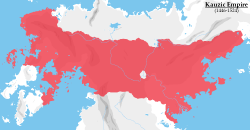Difference between revisions of "Neviran Empire"
(Created page with "{{Infobox former country |native_name = |conventional_long_name = Kauzic Empire |common_name = Kauzic Empire |continent = Baredina |region...") |
|||
| Line 84: | Line 84: | ||
<!-- Titles and names of the first and last leaders and their deputies --> | <!-- Titles and names of the first and last leaders and their deputies --> | ||
|leader1 = Emperor 1 | |leader1 = Emperor 1 | ||
|leader2 = [[ | |leader2 = [[Mov-Semt Ẓoɣ]] | ||
|leader3 = Emperor 3 | |leader3 = Emperor 3 | ||
|leader4 = | |leader4 = | ||
| Line 154: | Line 154: | ||
}} | }} | ||
The '''Kauzic Empire''' ([[Kauzic | The '''Kauzic Empire''' ([[Classical Kauzic]]: {{cs|KZP|kauz omj}}) was a large empire in [[Ekuosia]] and [[Püzimm]] that flourished during the Late Medieval and Early Modern Eras, and is often considered to be the bridge between the two eras. It was one of the largest empires in history, and one of the most influential in the history of [[Ekuosia]] and [[Püzimm]] despite only lasting 78 years. Because of the Kauzic Empire, various events were set in motion that drastically altered the political landscape of much of [[Baredina]] (and even [[Boroso]]), chief among such events being the introduction of firearms and advanced siege weaponry (to which the empire can attribute both its rapid expansion and its rapid downfall), the assimilation (or Kauzification) of various cultures and languages, and the death of several previously large and influential realms. | ||
==Etymology== | ==Etymology== | ||
Revision as of 00:47, 13 February 2017
| Kauzic Empire | |||||
| |||||
The Kauzic Empire at its greatest extent, c. 1500 CE.
| |||||
| Capital | Iru | ||||
| Languages | Kauzic languages, Adzamic languages, Yuja languages, Letsatian languages, Ekuostian language Argeyazic languages | ||||
| Religion | Mijism, Iovism, Adzamism, other faiths | ||||
| Government | Multidynastic militaristic autocracy | ||||
| Emperor | |||||
| • | 1446-1481 | Emperor 1 | |||
| • | 1481-1515 | Mov-Semt Ẓoɣ | |||
| • | 1515-1524 | Emperor 3 | |||
| Historical era | Late Medieval/Early Modern | ||||
| • | Proclaimed | 7 January 1446 | |||
| • | Collapsed | 16 August 1524 | |||
The Kauzic Empire (Classical Kauzic: kauz omj) was a large empire in Ekuosia and Püzimm that flourished during the Late Medieval and Early Modern Eras, and is often considered to be the bridge between the two eras. It was one of the largest empires in history, and one of the most influential in the history of Ekuosia and Püzimm despite only lasting 78 years. Because of the Kauzic Empire, various events were set in motion that drastically altered the political landscape of much of Baredina (and even Boroso), chief among such events being the introduction of firearms and advanced siege weaponry (to which the empire can attribute both its rapid expansion and its rapid downfall), the assimilation (or Kauzification) of various cultures and languages, and the death of several previously large and influential realms.
